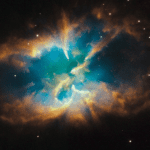 Weird Stuff
Weird Stuff  Weird Stuff
Weird Stuff  Our World
Our World 10 Ways Your Christmas Tree Is More Lit Than You Think
 Movies and TV
Movies and TV The 10 Coolest Stars to Set Sail on The Love Boat
 History
History 10 Things You Didn’t Know About the American National Anthem
 Technology
Technology Top 10 Everyday Tech Buzzwords That Hide a Darker Past
 Humans
Humans 10 Everyday Human Behaviors That Are Actually Survival Instincts
 Animals
Animals 10 Animals That Humiliated and Harmed Historical Leaders
 History
History 10 Most Influential Protests in Modern History
 Creepy
Creepy 10 More Representations of Death from Myth, Legend, and Folktale
 Technology
Technology 10 Scientific Breakthroughs of 2025 That’ll Change Everything
 Weird Stuff
Weird Stuff Ten Bizarre Facts About The Doge Meme
 Our World
Our World 10 Ways Your Christmas Tree Is More Lit Than You Think
 Movies and TV
Movies and TV The 10 Coolest Stars to Set Sail on The Love Boat
Who's Behind Listverse?

Jamie Frater
Head Editor
Jamie founded Listverse due to an insatiable desire to share fascinating, obscure, and bizarre facts. He has been a guest speaker on numerous national radio and television stations and is a five time published author.
More About Us History
History 10 Things You Didn’t Know About the American National Anthem
 Technology
Technology Top 10 Everyday Tech Buzzwords That Hide a Darker Past
 Humans
Humans 10 Everyday Human Behaviors That Are Actually Survival Instincts
 Animals
Animals 10 Animals That Humiliated and Harmed Historical Leaders
 History
History 10 Most Influential Protests in Modern History
 Creepy
Creepy 10 More Representations of Death from Myth, Legend, and Folktale
 Technology
Technology 10 Scientific Breakthroughs of 2025 That’ll Change Everything
Ten Mind-Bending Ideas About Black Holes
Black holes are bizarre yet fascinating objects. Regions of space and time are so dense and have such strong gravitational attraction that they consume anything and everything that might wander too close. Not even light can escape their pull, making it impossible to see directly. Instead, scientists scour the cosmos for a lack of photons—a sudden drop in light particles—or for the radiation they emit.
Technology in astronomy is constantly improving, and as it does, we move further forward in our understanding of these mysterious giants. Every month heralds a new breakthrough. Sometimes, it’s an observation of a black hole ripping a star to shreds or two of them devouring a shared gas cloud. At other times, scientists come up with extravagant new theories, like the idea of cosmic censorship or the idea that the universe, as we know it, might be part of a black hole of unimaginable size. Here are ten of the most breathtaking recent black hole moments for you to try and get your head around.
Related: 10 Enduring Space Mysteries That Spilled Their Secrets
10 Cosmic Censorship: Why We Cannot See the Inside of a Black Hole
Einstein’s theory of general relativity redefined the way we think about gravity. His groundbreaking work predicted points of infinite density scattered across the cosmos. These are known as singularities—points at which the fabric of time and space becomes distorted chaos, and the laws of physics fall apart. Singularities exist at the heart of every black hole.
So, how come when we look out at the universe, we don’t see these points contorting time and space into an unknowable cataclysm? For this, we turn to British physicist Roger Penrose. He proposed that singularities are shielded by the black holes’ event horizons. He called this idea the cosmic censorship conjecture.
Penrose’s hypothesis is fascinating, but it is based on scarce evidence. For decades, scientists have been unable to find much to prove or disprove it. Discoveries about the behavior of tiny particles could change all that. Researchers applied Penrose’s ideas to quantum mechanics and discovered what’s known as quantum cosmic censorship.
Scientists are now bringing in ideas around the mass and energy of space-time and the second law of thermodynamics. This far-out research could pave the way for a more rigorous explanation for why we cannot see the anarchic inequalities that lurk inside black holes.[1]
9 Supermassive Black Hole Defies All Theoretical Limits
At the heart of a galaxy 12 billion light-years from Earth lies a black hole like none other scientists have ever seen. Supermassive guzzler LID-568 eats up matter at 40 times the theoretical limit. It sucks in surrounding cosmic material and spews out intense X-ray emissions, which is what drew researchers to its existence. They located the record-breaking beast thanks to readings from the James Webb Space Telescope and Chandra X-ray Observatory.
The gargantuan glutton formed 1.5 billion years after the Big Bang. That might sound like an enormous amount of time, but the universe was still in its infancy. Scientists hope that by studying LID-568, they can learn how supermassive black holes became huge so soon after the Big Bang.[2]
8 Astronomers Chart Shape of Black Hole Corona
The word corona might make you shudder with awful memories of the global pandemic and COVID lockdown. But in the world of black holes, it means something very different. The corona refers to the extremely bright, hot region surrounding some black holes, sending out flares of X-rays. Each one is encircled by a whirlpool of heated gas and dust known as an accretion disk.
With some black holes, astronomers can see the accretion disks directly, while others are blocked out by space debris. It all depends on how they are positioned in relation to the Earth, whether the black holes are obscured or unobscured.
In a recent study into the corona, researchers collected data on obscured black holes from NASA’s Imaging X-ray Polarimetry Explorer (IXPE). They chose to inspect around a dozen cosmic giants, including Cygnus X-1 and X-3 in the Milky Way and LMG X-1 and X-3. X-rays emitted by the corona are scattered by nearby debris, some of which IXPE can pick up. Based on these patterns, astronomers confirmed that coronas form a disk-like structure. They hope similar techniques will help them better understand the mysterious behavior of elusive black holes.[3]
7 First Trinary Black Hole System Discovered
In October 2024, scientists announced they had found a trinary black hole system for the first time. Named V404 Cygni, the never-before-seen cosmic network features a black hole orbited by two stars. One star takes a wide orbit, circling once every 70,000 years, while the other completes a circuit in just six and a half days. Experts spotted the cosmic trio 7,800 light years from Earth in the Cygnus constellation. The team used data from the European Space Agency’s Gaia mission,
The idea of binary black hole systems—a black hole orbited by one star—is nothing new. But discovering a second satellite has left scientists scratching their heads. Stellar black holes like the one in V404 Cygni are said to form when enormous dying stars explode. According to current theory, any gravitational bond with the wide-orbiting star should have broken during the blast. But in this case, scientists believe the explosion must have been askew, which meant the connection stayed intact.
Researchers hope further study into triple systems will enhance our understanding of how black holes emerge. “Either we got very lucky, or tertiaries are common,” explained Caltech astronomer Kareem El-Badry. “If they are common, that might solve some of the long-standing questions about how black hole binaries form. Triples open up evolutionary pathways that are not possible for pure binaries.”[4]
6 Are We Living Inside a Black Hole?
What is the universe? When you look out at the night sky, it seems to stretch out forever. But could it all be one giant black hole? Some physicists believe it might be, and they’ve got some pretty nifty evidence to back up their wacky ideas.
As we currently understand, the universe has some similarities to a black hole. Scientists have calculated how a black hole would behave if it contained all the mass and energy we believe is in the universe. The result had roughly the same size and density as the observable universe. Physicists have also pointed out that the Big Bang—a moment in time so extreme that science as we know it falls apart—is similar to what lurks inside a black hole. There is even a theory suggesting that black holes can create baby universes within bigger universes.
The idea that everything as we know it could exist within one giant black hole is fascinating. However, fans of the theory have not yet produced any evidence to back up their wild imagings. For now, the truth is that we just don’t know.[5]
5 The Pair of Black Holes That Feast Together
Astronomers have discovered two supermassive black holes “sharing a meal” as they gobble up a gas cloud. The greedy pair can be found munching away at the heart of a galaxy known as 2MASX J21240027+340911. Together, their mass is 40 million times greater than the Sun, and the distance between them is around 16 billion miles (26 billion kilometers).
The pair are currently twirling through a gas cloud, orbiting each other. As they spin through the cosmos, the black holes consume gas from their surroundings. The guzzling twosome produces strange flares of light every 60 to 90 days. These patterns first appeared in readings from the Zwicky Transient Facility at the Palomar Observatory, then NASA’s Swift telescope. Unfortunately, the cooperative diners will have to finish their meal at some point. They are set to crash into each other in 70,000 years.[6]
4 Furthest Black Hole from Earth Ever Discovered
In 2023, astronomers discovered the most distant supermassive black hole ever found. They called it UHZ1. Light and X-rays from the area around UHZ1 first shone when the universe was 470 million years old. Although black holes cannot be seen directly, this is the oldest researchers have ever noticed. They found the record-breaking leviathan while scouring Abell 2744, a galaxy cluster 3.5 billion light-years from Earth.
The team used NASA’s Chandra X-Ray Observatory and James Webb Space Telescope. They also employed an advanced technique called gravitational lensing. Abell 2744 is such a dense cluster that it warps and curves the fabric of space and time. This curvation starts to act like a lens and magnifies light from distant objects that people wouldn’t have seen otherwise. Researchers calculated that when they look at UHZ1, they’re seeing something from when the universe was 3% of its current age.[7]
3 Astronomers Discover Black Hole After it Rips Star to Shreds
Some people know how to make an entrance. And perhaps some cosmic bodies do, too. An elusive black hole alerted scientists to its presence by tearing apart a stray star and eating it. Before then, it had gone unnoticed, lurking in a dwarf galaxy a million light-years from Earth. In the process, it gave out a spurt of radiation so powerful that it was brighter than every star in the dwarf galaxy combined.
Scientists describe moments like that as tidal disruption events—when an unlucky star wanders too close to a black hole and gets pulled apart by the immense gravitational force. The black hole, in this case, only has intermediate mass. But it’s still gargantuan enough to demolish the poor stellar object.
As astronomer Charlotte Angus explained, “The fact that we were able to capture this midsize black hole whilst it devoured a star offered us a remarkable opportunity to detect what otherwise would have been hidden from us. What is more, we can use the properties of the flare itself to better understand this elusive group of middle-weight black holes, which could account for the majority of black holes in the centers of galaxies.”[8]
2 Record-Breaking Plasma Jets Ejected by Black Hole
Scientists were taken aback in 2024 when they saw two colossal plasma jets spurting out of a supermassive black hole. The superhot streams sprung out of the top and bottom of the black hole, and together, their power is the same as trillions of suns. The pair spanned 23m light-years from end to end, the same distance as 140 Milky Ways. This eye-watering length earned them the name Porphyrion, a giant of Greek mythology.
Plasma jets are made up of streams of miniscule charged particles stimulated by the black hole until they approach the speed of light. Researchers have observed them spat out of black holes in the past, but nowhere near the size or intensity of Porphyrion. The record-breaking pair was spotted by Europe’s Low-Frequency Array (Lofar) telescope. Researchers believe it must have taken the jets a billion years to grow to such incredible length. Porphyrion is now inspiring scientists to reevaluate their ideas about how the universe evolved.[9]
1 Dark Energy May Be Created in Black Holes
Much like black holes, dark energy is another one of the fascinating mysteries of modern cosmology. It’s an unknown form of energy that impacts the universe’s expansion and is said to be a kind of “negative pressure.” Even though the theory has existed since the late 1990s, scientists still cannot explain what dark energy is.
Now, a team of free-thinking physicists from around the world has come up with a new idea: could dark energy be created inside black holes? Dark energy is usually assumed to be scattered across the universe, but these scientists disagree. Instead, they wonder if it might be created when large stars die and collapse to form black holes. The dark energy would then remain inside the core.
There are many skeptics of this wild idea, but in 2023, the team published two papers to back up their claims. They looked at black holes in different types of galaxies. In young galaxies, new stars are born in clouds of dust and gas, and many will be swallowed by black holes. This allows the black holes. But in dormant galaxies, no new stars are formed, which means there is no new matter for the black holes to consume. So how come, the physicists ask, black holes in dormant galaxies are so huge, seven to 20 times bigger than expected? They say there must be something else driving black hole growth in dormant galaxies and suggest it could be dark energy tucked away at their core.
“The importance of this work is that it’s taken the theories about black holes with dark energy cores and linked them for the first time to tangible observations of the universe,” said astronomer Chris Pearson from STFC RAL Space in Oxfordshire. “These black holes are expected to grow in mass as the universe expands.”[10]








